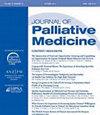摘要
背景:由于最近的文化和政治变革,医用大麻(MC)的使用日益增多。除 Lennox-Gastaut 和 Dravet 综合征患者外,没有足够的文献为儿童患者处方医用大麻提供循证支持。目标:描述在门诊儿科姑息治疗环境中接受 MC 建议的人群特征,并量化患者/家属报告的结果。设计:对电子病历(EMR)数据进行回顾性病历审查。设置/受试者:2019年至2022年期间,在美国中西部一家医院的姑息治疗部门内设的专科门诊接受MC相关医疗建议的连续患者(n=46)(n=42)和住院患者(n=4)。测量:人口统计学、诊断、症状、不良反应、患者报告的结果以及从 EMR 中提取的障碍。结果:我们的样本包括 46 名姑息治疗患者,平均年龄为 11.7 岁(SD 5.4);50% 的患者有神经系统诊断(n = 25);37% 的患者(n = 14)有血液/肿瘤诊断;13% 的患者(n = 6)有慢性疼痛诊断。最常见的 MC 推荐类型是 1:1 大麻二酚(CBD):四氢大麻酚(THC)酊剂。据统计,住院天数和费用明显减少。总共有 35% 的患者能够减少或停用其他药物。主题分析确定了四种使用障碍(产品不可用、难以获得州管委会卡、费用和组织)和主观症状改善情况。结论:这些数据反映了我们儿科医院姑息关怀 MC 诊所人群的特点。在多个症状领域都取得了积极成果。MC似乎与降低医疗利用率、减少多重用药、提高生活质量有关,而且在使用过程中没有出现明显的不良反应。在注重价值的医疗环境中,这些数据值得进一步探讨。Background: Medical cannabis (MC) is increasingly in use due to recent cultural and political changes. Other than patients with Lennox-Gastaut and Dravet syndrome, there is inadequate literature to provide evidence-based support for prescribing MC in pediatric patients. Objectives: Characterize the population receiving an MC recommendation in an ambulatory pediatric palliative care setting and quantify patient/family-reported outcomes. Design: Retrospective chart review of electronic medical record (EMR) data. Setting/Subjects: Total n = 46 consecutive patients receiving medical advice regarding MC (n = 42) in a specialized ambulatory clinic embedded in a palliative care division and n = 4 inpatient in a midwestern U.S. hospital between 2019 and 2022. Measurements: Demographics, diagnosis, symptoms, adverse reactions, patient-reported outcomes, and barriers abstracted from EMR. Results: Our sample included 46 palliative care patients with a mean age of 11.7 years (SD 5.4); 50% had a neurological diagnosis (n = 25); 37% (n = 14) hematological/oncologic; and 13% (n = 6), chronic pain. The most common type of MC recommended was 1:1 Cannabidiol (CBD): tetrahydrocannabinol (THC) tincture. There was a statistically significant decrease in inpatient floor days and cost. Totally, 35% of patients were able to decrease or discontinue other medications. Thematic analysis identified four barriers to use (product unavailable, difficulty obtaining state MC card, cost, and organizational) and subjective symptom improvement. Conclusions: These data characterize the palliative care MC clinic population at our pediatric hospital. Positive outcomes were noted across several symptom domains. MC seems to be associated with lower health care utilization, reduced polypharmacy, and increased quality of life and was used without significant adverse events. In a value-conscious health care environment, the data warrant further exploration.

 求助内容:
求助内容: 应助结果提醒方式:
应助结果提醒方式:


